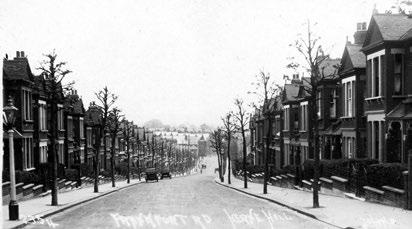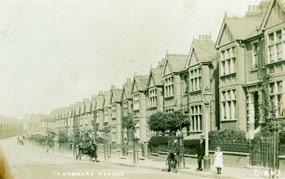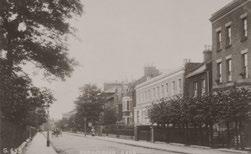
5 minute read
Herne Hill’s street trees
Jeff Segal tells the story
Frankfurt Road c1920
Advertisement
Herne Hill is a lovely, leafy place, with more street trees than in most inner London districts. There are roughly 1,500 altogether, spread rather unevenly over 100 streets, with about two-thirds of them on the Southwark side of SE24. Their story begins in the 1860s, when two things happened that would reshape the area dramatically. First, the railways arrived, with Herne Hill station opening in 1862 and North Dulwich six years later. Fast trains into the city were the catalyst for developers to start breaking up the grand properties of the merchant classes along Denmark Hill and Herne Hill and laying out streets of suburban housing.
Until then the villas of the wealthy were “so graciously concealed by the fine trees of their grounds”, as John Ruskin put it, that the mile-long carriage ride from Camberwell might have seemed like a woodland drive. Old boundary trees or meadow trees would have heightened Ruskin’s sense of “leafy seclusion”, like the ancient elm at 50 Half Moon Lane or the aspens on Simpson’s Alley (now Ruskin Fawnbrake Avenue c1910 Walk).
At the same time, a few miles north, construction began on Joseph Bazalgette’s revolutionary sewer system for London, designed to clean up the stinking, insanitary River Thames. A key element was the Thames Embankment, built on marshland on the north shore. The section between Westminster and Blackfriars bridges housed the main sewer from west London, gas and water pipes and the District Railway tube tracks beneath a major new road
Most of London up to this point was a tangle of winding, narrow streets, but this remarkable avenue along the Thames gave the Metropolitan Board of Works the space and the opportunity to emulate the much admired tree-lined boulevards of Paris and other grand European capitals. In 1869, before the carriageway, railway and sewer were even finished, hundreds of London plane trees were planted at 20 ft intervals along the new 20 ft wide riverside footway. This was the first time that street trees of any species had been planted at a large scale in the capital. The London plane (Platanus x hispanica) had been known in Britain for almost 300 years and was selected for its tolerance of pollution from coal fires and the factory chimneys along the river. In Street Trees in Britain: a History, Mark Johnston writes that the lines of planes soon extended along Northumberland Avenue, then crossed the Thames to St George’s Road, Blackfriars Road and Tooley Street.
They reached Herne Hill by the turn of the century. By then the new residential streets of Poets’ Corner, the Milkwood Estate and the roads around Kestrel Avenue were well established, but the streets between Herne Hill and the railway viaduct from North


Herne Hill c1895
Dulwich were incomplete. It was in this area, at the parade of shops built in 1899-1900 opposite the Half Moon pub, that the columns of planes began. They stretched along Half Moon Lane into Beckwith Road, Ardbeg Road, Elmwood Road and Nairne Grove, and then up to the top of Sunray Avenue. Poplar Walk has another 16 London planes, the only ones found on the Lambeth side. Apart from a few losses all those old trees – over 170 of them – are still cooling and shading our pavements.
Trees soon began to appear on the new side streets too. Before the council adopted a road, housing developers and residents had to pay for any planting, and not everyone wanted to take on the expense. Still, contemporary photos and postcards show dense, regular planting on five middle-class streets by around 1905: Danecroft Road, Elfindale Road, Fawnbrake Avenue, Frankfurt Road and Hollingbourne Road, each with one identical tree for every two houses.
It’s difficult to make out the species from grainy pictures, but the tightly packed trees on Frankfurt, for example, were likely to have been London planes. Once they grew it would have become apparent that they were too big for the location and they wouldn’t have lasted long. Even on Half Moon Lane the five planes between what’s now Oliver Burn and Bon Velo had been removed by 1912. Some big limes in the neighbourhood might be survivors from this era, though.
On other more affluent roads like Croxted Road, Guernsey Grove, Stradella Road and Winterbrook Road, rather than planting trees the builders often put pleached limes in the front gardens. Pleaching is where selected branches and twigs of young limes are stretched out horizontally to intertwine with the next tree along, eventually creating a clipped hedge on top of a row of clear trunks. There are traces of them all over Herne Hill and some are still maintained, among them a fine double-decker hedge at 26 Half Moon Lane.
In the Edwardian years there were also some pleached limes in Poets’ Corner – Chaucer Road, Milton Road, Shakespeare Road and Spenser Road – but the deep front gardens were big enough to plant tall trees and thick hedges and period photos show them looking abundant.
Limes and London planes were clearly the species of choice at this time, but as H.J. Dyos noted in Victorian Suburb, his history of house-building in Camberwell, social class determined what type of tree, if any, your street would get: “Planes and horse chestnuts for the wide avenues and lofty mansions of the well-to-do; limes,
laburnums and acacias for the middle incomes; unadorned macadam for the wage-earners.”
“Unadorned macadam” is evident in early pictures of workingclass streets in Lambeth. On the Milkwood Estate – Lowden Road, Milkwood Road, Poplar Walk Road (later Poplar Road) and Jessop Road (now gone) – there isn’t a single tree to be seen. Railton Road had some hedges and small shrubs or trees in the shallow front yards by the mid-1920s, but Mayall Road remained largely bare.
By contrast the Sunray Estate – municipal housing dating from 1921-22 – had trees at its very heart. Designed along garden-city principles, the cottage-style dwellings with generous front and back gardens and privet hedges were picturesquely sited among wide grass verges, quiet green squares, cul-de-sacs and veteran oaks from Casino House. Other old trees lived on in Sunray Gardens, the small park opening at the same time as the estate.
The second part of this story will appear in the next issue.

Shakespeare Road c1900 Sunray Avenue c1900


Wanless Road c1975







